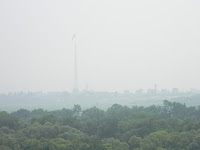
In 2010, the country of Kenya (eastern Africa) wrote a new constitution to restructure its government for the sake of efficiency. Despite Swahili and English as common economic and political languages, this country of 580,367 square kilometers experiences significant cultural, ethnic, and linguistic diversity. Since gaining independence from the United Kingdom in 1963, Kenya has experienced less cultural conflict than many other African countries. Yet, a country with such diversity of peoples often had difficulty of fully meeting the needs of such a diverse population. Thus, the new constitution created a system of federalism (similar to the United States) in which the national government would share power and responsibilities with 47 county governments (comparable to the 50 U.S. states).
With not having had a background in federalism, various international leaders, including my friend Jerry Regier, have been invited by the Kenyan government to lead seminars the political ethics involved within democratic federalism. Kenyan leaders have also made a variety of study tours within the United States. One such study tour has brought a delegation of Kenyan Governors to Oklahoma.
 Tonight, I had the opportunity attend a reception held at Express Ranch (home of Bob Funk) and sponsored by Water4 in honor of this Kenyan delegation. It was an honor to meet:
Tonight, I had the opportunity attend a reception held at Express Ranch (home of Bob Funk) and sponsored by Water4 in honor of this Kenyan delegation. It was an honor to meet:
Wycliffe Oparanya Ambesta, Governor of Kakamega
Peter Munya, Governor of Meru
Mohamad Ahmed Abdulahi, Governor of Wajir
Joshua Irungu Wakahora, Governor of Laikipia
Rutto Isaac Kiprono, Governor of Bomet
Johnathan Mueke, Deputy Governor of Nairobi
Evelyne Aruasa, Deputy Governor of Narok
and their associates holding other governmental offices
This delegation arrived Sunday evening. They then spent Monday touring agricultural sights and the Water4 production facilities. Today they met with several Oklahoma government officials at the Capitol and will meet with others, including Lt. Governor Todd Lamb, tomorrow. Jerry Regier has facilitated their visit to Oklahoma and is already planning a return trip to Kenya in hopes of taking some other Oklahoma leaders with him.
Personally, it was great to visit in-depth with a couple of these delegates and share my own experiences of having visited Kenya in 2001 and 2002. I've been invited back...so perhaps that can happen sooner than later.
 |
| pavilion at Express Ranch |
 |
| His Excellency Wycliffe Oparanya Ambetsa, Governor of Kakamega & Delegation Head, presents formal greetings on behalf of the delegations |





























































